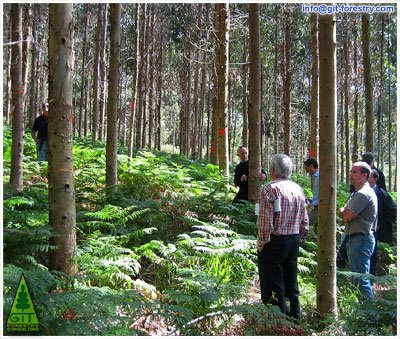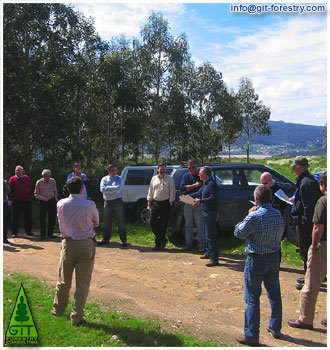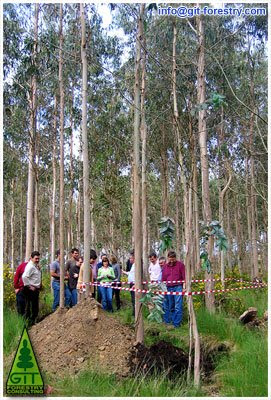Independent External Auditory Test to NORFOR’s Sustainable Forestry Management in Galicia (Mini-Audit)

I) Introduction
II) Objectives
The main objective of our visit was keeping track of any visible evidence of clear contradiction between management practices and criteria & indicators for sustainable forest management required for any of the certification schemes. Observations were made during the visit on key factors affecting sustainable forestry management from environmental, social and economic standpoints.
- Hypothesis 1: “NORFOR’s relationship with Stakeholders is not transparent”
- Hypothesis 2: “NORFOR’s relationship with Stakeholders is not participatory”
- Hypothesis 3: “NORFOR’s Integrated Management System does not follow Sustainable Forestry methodologies”
- Hypothesis 4: “NORFOR’s forestry management practices create generalised irreversible negative environmental impacts”
- Hypothesis 5: “NORFOR’s forestry management practices involve indiscriminate use of herbicides as glyphosate”
- Hypothesis 6: “NORFOR’s forestry management practices show a complete lack of promotion of the use of native species in their plantations”
- Hypothesis 7: “Galician based Environmental NGO public criticism of NORFOR’s forestry management practices is based on technical and/or scientific criteria”
A summary of relevant facts arising while visiting and observations taking place during the field day follows, with special emphasis on key observations related to the social & environmental sustainability of NORFOR’s forestry management practices. A full report is on preparation and can be made available to PEFC-Spain and FSC-Spain through us upon request.
III) Participating Stakeholders
- Representatives of societies of Galician cultivated forest owners & silviculturalists
- Individual Galician cultivated forest owners & silviculturalists leasing land use to NORFOR
- Independent individual Galician cultivated forest owners & silviculturalists not leasing land use to NORFOR
- Independent Galician timber supply chain representatives
- International forestry scientists
- Sectorial Galician forestry industry representatives
- Galician FSC Support Group representatives
- Representatives of Galician Universities
- Independent social agents related to forestry
- NORFOR forestry technical management staff
- NORFOR higher management staff
- NORFOR forestry workers
IV) Non Participating Stakeholders
V) Technical Visit Documentation
- A comprehensive field programme for the visit was supplied
- Location data and relevant summarised data on forestry management were provided for each visited cultivated forest
- Suitable cartography with relevant spatial data on forest management were provided for each visited cultivated forest
- Extra documentation was provided to complement in situ descriptions, including:
- Description of NORFOR's Integrated Management System
- Description of NORFOR's policy for Riparian Habitat Management
- Description of NORFOR's methodology for Visual Impact Assessment & Minimisation at landscape level
- Description of NORFOR's methodology for Stakeholder Participation Assessment
- Summary of existant NORFOR's Forestry Management Methodologies for five types of tree species present in their managed landbase: Quercus robur (oak, carballo), Castanea sativa (chestnut, castiñeiro), Pinus pinaster (maritime pine, piñeiro do país), Eucalyptus nitens (shining gum, eucalipto das xeadas) & Eucalyptus globulus (Tasmanian blue gum, eucalipto do país)
- Summary of performance results for NORFOR's genetically improved plantations
- Summary of NORFOR's Management Strategies for Forestlands with High Value for Conservation within their landbase
- Summary of ENCE Group Management Policy
- Public Summary of NORFOR's Technical Management Plan
- Public Summary of NORFOR's General Management Plan
- Public Summary of ENCE Group Strategic Plan 2007-2011
VI) Key Observations on the environmental sustainability of NORFOR’s forestry practices
- Data were presented to participating stakeholders on general forestry management regimes applied by NORFOR to the main tree species present in their owned and leased landbase. These comprise 9 different silvicultural regimes applying to both native (Quercus robur) and naturalised species (Castanea sativa, castiñeiro; Pinus pinaster, piñeiro do país; Eucalyptus nitens, eucalipto das xeadas; Eucalyptus globulus, eucalipto do país).
- Only a 3.5% of total landbase under NORFOR’s management is affected by any of the existent habitat protection figures. Just a 2% of total landbase under NORFOR’s management and at once affected by protection figures is effectively afforested with Eucalyptus, and in that particular case, planting took place before these protection figures were implemented. For these Forestland with High Value for Conservation areas NORFOR has developed special management prescriptions involving low impact silviculture, gradual replacement of industrial timber crops with native species once production cycle is over, creation of buffer zones outside of the affected areas and feasibility studies to implement native habitat corridors. An example of a management unit partially categorised under existent habitat protection figures was visited.
- Soil properties are monitored for the major soil types where NORFOR's cultivated forests are established. Different soil monitoring sites were inspected during the visit. This process allows regular short and long term tracking of key soil physical and chemical properties by a relevant external party & adapting management prescriptions to current and future soil status, hence securing sustainable long term availability of nutrients and minimising risks of nutrient depletion.
- Buffer zones of native riparian vegetation are nowadays reasonably preserved near water courses along the boundaries of NORFOR's management units visited, and this trend was stated as increasingly favoured as management principle for the whole landbase.
- New buffer zones of native riparian vegetation are promoted within NORFOR's own or leased properties visited to protect natural drainage lines and minimise erosion risks. This trend was stated as increasingly favoured as management principle for the whole landbase.
- Operations for the removal of naturalised Eucalyptus specimens growing in buffer zones along the boundaries of and within NORFOR’s management units were observed during the visit. It was stated that depending on quality of buffer corridors, specific activities of riparian native tree plantation are also undertaken.
- Mechanical clearing of cultivated forest understorey was the only type of weed control operation observed during the visit and having impact on sizeable areas. It is estimated there are 19% chances to randomly observe a weed control operation among all interventions performed in a given hectare of NORFOR’s management units along its life cycle. Among the latter, 75 to 87% of total understorey control operations are not based on the use of phyto-chemicals , with some variation depending on site conditions and stand evolution after clearing.
- Spatial impact of the use of herbicides is estimated at a 3 to 5% of total landbase acreage under NORFOR’s management per year. Furthermore, the impacted area is not concentrated over the same water catchment, but spread within as many as existent management units in which this practice is implemented, meaning a dispersal of spatial impact.
- Temporal impact of the use of herbicides is estimated at a 3 to 6% of cultivation cycle life span for a given hectare under NORFOR’s management, meaning a dispersal of temporal impact.
- Sound scientific methodologies are being applied to the development of a Protocol to Minimise Visual Impact of NORFOR’s forestry management practices. A review of these methodologies and their potential positive impact on management practices was presented to participating stakeholders. This protocol will be the first step for the operational implementation of as less impacting visual footprint as possible at a landscape level.
 Fig. 3: Stakeholders observing one of NORFOR's Permanent Inventory plots in a stand subject to standard silviculture. Note the existance of understorey plants.
Fig. 3: Stakeholders observing one of NORFOR's Permanent Inventory plots in a stand subject to standard silviculture. Note the existance of understorey plants.- A summary of NORFOR’s Stakeholder Participation Assessment was presented to participating stakeholders, describing behaviour of different groups of stakeholders since 2004. Over 300 different interested parties have participated in this process since its inception. Environmental NGO’s account to a 3% of total participation for the period 2004-2006. Participation rate by Environmental NGO has fallen to 0% since 2006.
- Suitable documentation was provided by NORFOR’s staff to participating stakeholders in order to receive feedback and improve this system. This established feedback mechanism gives the opportunity to participating stakeholders to provide their individual or collective views on how to improve the sustainability of NORFOR’s forestry management. Highest rates of successful feedback since 2004 are associated to stakeholder categories University/Research and Clients. Environmental NGO feedback for suggestions or alternatives to improve the sustainability of NORFOR’s forestry management account a 0% over total received since 2004.
- EUCALYPTOLOGICS witnessed more than 200 questions (general, specific, technical and related to the three main angles of sustainability) being presented to NORFOR’s staff by different stakeholders during the field day. Lack of transparency by NORFOR’s technical and non technical staff was not observed at the time of answering these questions. In addition, exchange of information between stakeholders different to NORFOR was also noticeable and evaluated as positive.
VIII) Conclusions
A) Principal Objective
Direct, neutral, impartial and objective observation conducted during the Fourth Forestry Field Day with Stakeholders allowed the following test results for the initial working hypothesis:
- Hypothesis 1: “NORFOR’s relationship with Stakeholders is not transparent”. Evaluation: FALSE. Recommendation: Reformulate
- Hypothesis 2: “NORFOR’s relationship with Stakeholders is not participatory”. Evaluation: FALSE. Recommendation: Reformulate
- Hypothesis 3: “NORFOR’s Integrated Management System does not follow Sustainable Forestry methodologies”. Evaluation: FALSE. Recommendation: Reformulate
- Hypothesis 4: “NORFOR’s forestry management practices create generalised irreversible negative environmental impacts”. Evaluation: FALSE. Recommendation: Reformulate
- Hypothesis 5: “NORFOR’s forestry management practices involve indiscriminate use of herbicides as glyphosate”. Evaluation: FALSE. Recommendation: Reformulate
- Hypothesis 6: “NORFOR’s forestry management practices show a complete lack of promotion of the use of native species in their plantations”. Evaluation: FALSE. Recommendation: Reformulate
- Hypothesis 7: “Galician based Environmental NGO public criticism of NORFOR’s forestry management practices is based on technical and/or scientific criteria”. Evaluation: FALSE. Recommendation: Reformulate
IX) Recommendations
We recommend Norte Forestal SA to keep developing their internal protocols to minimise negative social and environmental impacts of forestry management in their owned and leased landbase.
X) References
[1] = FSC-Watch (20 May 2008) - ADEGA withdraws its support to FSC due to bad practices of NORFOR. www.fsc-watch.org
[4] = Verdegaia (22 Jun 2007) - Plante das organizacións ecoloxistas a NORFOR (ENCE). www.verdegaia.org


WORLD ENVIRONMENT DAY 2008
I'm reducing my carbon footprint by planting efficient carbon sinks! And you?
EUCALYPTOLOGICS must contribute to a proper dissemination of sound information and to the education of general audience on these important topics no matter if at local, regional, national or global scale. And renewable, recyclable and sustainable primary resources as Eucalyptus timber is can achieve the category of strategic from many standpoints. Our overpopulated greenish Gaia and its friends keep needing of a wise use of their finite resources to support themselves in the long term or they will perish.
Subscribe to receive EUCALYPTOLOGICS via RSS






Manual Trackback: Auditing NORFOR Sustainable Forestry: Much Ado about NothingDigg.com
ReplyDelete